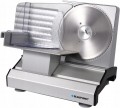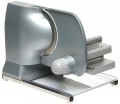Power
The total power consumption of the slicer. The value of this parameter is small — the performance of even the most powerful models usually does not exceed 200 W.
Almost all the power consumed is for operation of the engine, so the higher
it is, the more powerful the engine is installed in the slicer. Theoretically, the higher power allows you to better cope with solid and dense products, but in fact everything also depends on the characteristics of the knife — primarily its type (see below) and the quality of sharpening. Therefore, power data are more reference than practically significant, and this indicator has almost no effect on the quality of the slicer.
Blade diameter
The diameter of the blade of the knife supplied with the slicer. Knives are shaped like discs — accordingly, the diameter of the blade is actually equal to the diameter of the disc.
The larger the blade, the larger ingredients the device can handle at a time and the “larger” the cut slices can be. At the same time, in fact it is rarely necessary to use a slicer for very thick products. Therefore, even in the most “large-caliber” modern models, the knife diameter usually does not exceed 300 mm.
Min. thickness of slice
The smallest thickness of slices that a slicer can separate from the cut product.
The modern slicers, usually, allow you to adjust the thickness of the slices — an important feature in light of the fact that for different situations and products, the optimal thickness will be different. It is worth paying attention to the minimum thickness if the ability to cut graceful thin slices is important for you — for example, for serving a holiday table, on which food should be not only tasty, but also beautiful.
Max. thickness of slice
The greatest thickness of the slices that the slicer can separate from the cut product.
The modern slicers usually allow you to adjust the thickness of the slices — an important feature in light of the fact that for different situations and products, the optimal thickness will be different. The ability to separate thick slices can be useful, for example, when cutting bread, or when preparing fruit for jam or compote. Such situations are not uncommon, therefore, in most modern slicers, the maximum thickness is more than 10 mm.
Protection from accidental activation
The presence
of protection from accidental activation in the design of the slicer.
One of the most popular options for such protection is the use of two power buttons: in order for the knife to move, you need to hold down both. This format of work minimizes the chance of accidental start — for example, if you touch the button while correcting the cut product in the immediate near the blades. In addition, this function can also play the role of child lock: the buttons are often made quite tight so that only an adult can press them.
Compartment for cord
The presence
of a compartment for the power cord in the design of the slicer.
This feature greatly simplifies the storage and transportation of the device: the cord can be placed compactly inside the slicer body, and it will not hang out, cling to other objects and create other inconveniences. And in some models, the compartment may have devices for uniform winding, which makes it easier to lay the wire and avoid damage due to bending.

